Effect of Metal Cations with Different Valences on the Humus Composition of Dark-Brown Soil Mixed with Tilia Wood Shavings
Abstract
:1. Introduction
2. Materials and Methods
2.1. Materials
2.2. Methods
2.3. Analysis
2.4. Statistical Analysis of the Data
3. Results
3.1. Total Organic C Content and C Content of Water-Soluble Substances (CWSS)
3.2. C Content (CHE) and ∆logK Value of Humic-Extracted Acid
3.3. Atomic Ratio and FTIR Spectra of Humic Acid (HA)
3.4. Humification Index (CHA/CFA Ratio)
3.5. C Content of Humin (CHu)
4. Discussion
4.1. TOC and CWSS
4.2. CHE and ∆logK Value of HE
4.3. Structural Characteristics of HA Molecules
4.4. CHA/CFA Ratio
4.5. CHu
5. Conclusions
- (1)
- The addition of metal cations could effectively improve the utilization and consumption of WSS by microorganisms regardless of their valence state, as Fe3+ > Mn2+ > K+. The addition of three metal cations could effectively inhibit mineralization and reduce the loss of TOC, and the effect could be seen as follows: Fe3+ > Mn2+ > K+.
- (2)
- Although the CHE content first decreased and then increased with incubation, the addition of Fe3+ and Mn2+ ions increased the CHE content, showing that Fe3+ > Mn2+ and K+ ions had no significant effect. Throughout the incubation, the structure of HE molecules experienced a complex first and then a simple process. Comparing the change before and after the incubation, the overall structure of HE molecules tended to be simpler in the CK control, and HE became more complicated with the addition of Fe3+ and Mn2+; however, the addition of K+ had little effect on the structure of HE molecules.
- (3)
- After incubation, the addition of Fe3+, Mn2+, and K+ ions strengthened the molecular condensation of HA and its aromatization degree, while the CK control without any added metal cations caused HA molecules to decompose and obtain a greater degree of aliphatic content. In addition, the number of O-containing functional groups and N-containing compounds in HA molecules increased to varying degrees regardless of which metal cation was added. The decomposition of Tilia wood chips led to a partial entry of the decomposition products into the HA component, which was then reconsumed by continuous mineralization. After the end of incubation, the polysaccharides in HA molecules were consumed only with the addition of Mn2+. Fe3+ and Mn2+ ions had greater advantages in increasing the CHA/CFA ratio and improving humus quality than K+ ions.
- (4)
- The addition of metal cations could effectively inhibit the mineralization and decomposition of the Hu component, among which Fe3+ ions had the most significant effect, followed by Mn2+ ions.
Author Contributions
Funding
Data Availability Statement
Conflicts of Interest
References
- Mouvenchery, Y.K.; Kučerík, J.; Diehl, D.; Schaumann, G.E. Cation-mediated cross-linking in natural organic matter: A review. Rev. Environ. Sci. Bio. 2012, 11, 41–54. [Google Scholar]
- Iskrenova-Tchoukova, E.; Kalinichev, A.G.; Kirkpatrick, R.J. Metal cation complexation with natural organic matter in aqueous solutions: Molecular dynamics simulations and potentials of mean Force. Langmuir 2010, 26, 15909–15919. [Google Scholar]
- Galicia-Andrés, E.; Escalona, Y.; Oostenbrink, C.; Tunega, D.; Gerzabek, M.H. Soil organic matter stabilization at molecular scale: The role of metal cations and hydrogen bonds. Geoderma 2021, 401, 115237. [Google Scholar]
- Merino, C.; Fontaine, S.; Palma, G.; Matus, F. Effect of aluminium on mineralization of water extractable organic matter and microbial respiration in southern temperate rainforest soils. Eur. J. Soil Biol. 2017, 82, 56–65. [Google Scholar]
- Kraal, P.; Nierop, K.G.J.; Kaal, J.; Tietema, A. Carbon respiration and nitrogen dynamics in Corsican pine litter amended with aluminum and tannins. Soil Biol. Biochem. 2009, 41, 2318–2327. [Google Scholar]
- Percival, H.J.; Parfifitt, R.L.; Scott, N.A. Factors controlling soil carbon levels in New Zealand grasslands: Is clay content important? Soil Sci. Soc. Am. J. 2000, 64, 1623–1630. [Google Scholar]
- Wang, Q.; Yang, P.; Zhu, M.Q. Effects of metal cations on coupled birnessite structural transformation and natural organic matter adsorption and oxidation. Geochim. Cosmochim. Ac. 2019, 250, 292–310. [Google Scholar]
- Sutton, R.; Sposito, G. Molecular simulation of humic substance-Ca-montmorillonite complexes. Geochim. Cosmochim. Ac. 2006, 70, 3566–3581. [Google Scholar]
- Rakhsh, F.; Golchin, A.; Agha, A.B.A.; Alamdari, P. Effects of exchangeable cations, mineralogy and clay content on the mineralization of plant residue carbon. Geoderma 2017, 307, 150–158. [Google Scholar]
- Fukuchi, S.; Miura, A.; Okabe, R.; Fukushima, M.; Sasaki, M.; Sato, T. Spectroscopic investigations of humic-like acids formed via polycondensation reactions between glycine, catechol and glucose in the presence of natural zeolites. J. Mol. Struct. 2010, 982, 181–186. [Google Scholar]
- Takashi, K.; Ikuko, I.; Hirotaka, S.; Ho-Dong, P.; Hideshige, T.; Shigeto, O.; Kazunari, N.; Kazutoshi, S.; Keishi, S. Aluminum and acidity suppress microbial activity and biomass in acidic forest soils. Soil Biol. Biochem. 2016, 97, 23–30. [Google Scholar]
- Feng, X.J.; Simpson, A.J.; Simpson, M.J. Chemical and mineralogical controls on humic acid sorption to clay mineral surfaces. Org. Geochem. 2005, 36, 1553–1566. [Google Scholar] [CrossRef]
- Cheng, H.J.; Yang, T.; Jiang, J.; Lu, X.H.; Wang, P.X.; Ma, J. Mn2+ effect on manganese oxides (MnOx) nanoparticles aggregation in solution: Chemical adsorption and cation bridging. Environ. Pollut. 2020, 267, 115561. [Google Scholar] [CrossRef] [PubMed]
- Iorio, E.D.; Circelli, L.; Angelico, R.; Torrent, J.; Tan, W.F.; Colombo, C. Environmental implications of interaction between humic substances and iron oxide nanoparticles: A review. Chemosphere 2022, 303, 135172. [Google Scholar] [CrossRef] [PubMed]
- Mei, J.; Ji, K.; Su, L.H.; Wu, M.T.; Zhou, X.J.; Duan, E.S. Effects of FeSO4 dosage on nitrogen loss and humification during the composting of cow dung and corn straw. Bioresour. Technol. 2021, 341, 125867. [Google Scholar] [CrossRef]
- Bui, V.K.H.; Truong, H.B.; Hong, S.; Li, X.W.; Hur, J. Biotic and abiotic catalysts for enhanced humification in composting: A comprehensive review. J. Clean. Prod. 2023, 402, 136832. [Google Scholar] [CrossRef]
- Zhang, X.M.; Zong, Y.; Xu, L.Q.; Mao, Y.F.; Wu, D.L. Enhanced abiotic integrated polyphenol-Maillard humification by Mg/Fe layered double hydroxide (LDH): Role of Fe(III)-polyphenol complexation. Chem. Eng. J. 2021, 425, 130521. [Google Scholar] [CrossRef]
- Tiwari, J.; Ramanathan, A.; Bauddh, K.; Korstad, J. Humic substances: Structure, function and benefits for agroecosystems—A review. Pedosphere 2023, 33, 237–249. [Google Scholar]
- Paul, E.A. The nature and dynamics of soil organic matter: Plant inputs, microbial transformations, and organic matter stabilization. Soil Biol. Biochem. 2016, 98, 109–126. [Google Scholar]
- Miura, A.; Okabe, R.; Izumo, K.; Fukushima, M. Influence of the physicochemical properties of clay minerals on the degree of darkening via polycondensation reactions between catechol and glycine. Appl. Clay Sci. 2009, 46, 277–282. [Google Scholar] [CrossRef]
- Liu, M.M.; Zhao, Z.Y.; Lu, Q.X.; Yu, W.Z. Release of dissolved organic carbon from biochar and formation of humic-like component during photoreaction: Effects of Ca2+ and pH. Water Res. 2022, 219, 118616. [Google Scholar] [CrossRef] [PubMed]
- Zhang, Y.C.; Xu, Y.; Yu, X.L.; Li, J.K.; Chen, G.; Wang, S.J.; Xu, Y.P.; Xu, R.; Zhang, B.H.; Zhang, H.Q. Microbial metabolism and humic acid formation in response to enhanced copper and zinc passivation during composting of wine grape pomace and pig manure. Bioresour. Technol. 2023, 384, 129226. [Google Scholar] [CrossRef] [PubMed]
- Qi, H.S.; Wang, J.L.; Zhang, L.Y.; Chen, L.H.; Zhao, Y.; Wei, Z.M. Activation effect of catechol on biotic and abiotic factors of humus formation during chicken manure composting. Waste Manag. 2022, 149, 146–155. [Google Scholar] [CrossRef] [PubMed]
- Wei, S.X.; Li, Z.C.; Sun, Y.; Zhang, J.M.; Ge, Y.Y.; Li, Z.L. A comprehensive review on biomass humification: Recent advances in pathways, challenges, new applications, and perspectives. Renew. Sust. Energy Rev. 2022, 170, 112984. [Google Scholar] [CrossRef]
- Liu, Y.; Ma, R.N.; Li, D.Y.; Qi, C.R.; Han, L.N.; Chen, M.; Li, G.X. Effects of calcium magnesium phosphate fertilizer, biochar and spent mushroom substrate on compost maturity and gaseous emissions during pig manure composting. J. Environ. Manag. 2020, 267, 110649. [Google Scholar] [CrossRef]
- Zhang, Y.L.; Yao, S.H.; Cao, X.Y.; Schmidt-Rohr, K.; Olk, D.C.; Mao, J.D.; Zhang, B. Structural evidence for soil organic matter turnover following glucose addition and microbial controls over soil carbon change at different horizons of a Mollisol. Soil Biol. Biochem. 2018, 119, 63–73. [Google Scholar] [CrossRef]
- Tao, Z.D.; Liu, X.C.; Sun, L.L.; He, X.X.; Wu, Z.S. Effects of two types nitrogen sources on humification processes and phosphorus dynamics during the aerobic composting of spent mushroom substrate. J. Environ. Manag. 2022, 317, 115453. [Google Scholar] [CrossRef]
- Zhu, N.; Zhu, Y.; Li, B.; Jin, H.; Dong, Y. Increased enzyme activities and fungal degraders by Gloeophyllum trabeum inoculation improve lignocellulose degradation efficiency during manure-straw composting. Bioresour. Technol. 2021, 337, 125427. [Google Scholar] [CrossRef]
- Aquino, A.J.A.; Tunega, D.; Pašalić, H.; Haberhauer, G.; Gerzabek, M.H.; Lischka, H. The thermodynamic stability of hydrogen bonded and cation bridged complexes of humic acid models—A theoretical study. Chem. Phys. 2008, 349, 69–76. [Google Scholar] [CrossRef]
- Aquino, A.J.A.; Tunega, D.; Schaumann, G.E.; Haberhauer, G.; Gerzabek, M.H.; Lischka, H. Proton transfer processes in polar regions of humic substances initiated by aqueous aluminum cation bridges: A computational study. Geoderma 2014, 213, 115–123. [Google Scholar] [CrossRef]
- Majzik, A.; Tombácz, E. Interaction between humic acid and montmorillonite in the presence of calcium ions I. Interfacial and aqueous phase equilibria: Adsorption and complexation. Org. Geochem. 2007, 38, 1319–1329. [Google Scholar] [CrossRef]
- Murano, H.; Suzuki, K.; Kayada, S.; Saito, M.; Yuge, N.; Arishiro, T.; Watanabe, A.; Isoi, T. Influence of humic substances and iron and aluminum ions on the sorption of acetamiprid to an arable Soil. Sci. Total Environ. 2018, 615, 1478–1484. [Google Scholar] [CrossRef] [PubMed]
- Martinez, R.E.; Sharma, P.; Kappler, A. Surface binding site analysis of Ca2+-homoionized clay–humic acid complexes. J. Colloid Interf. Sci. 2010, 352, 526–534. [Google Scholar] [CrossRef]
- Marsac, R.; Banik, N.L.; Lützenkirchen, J.; Catrouillet, C.; Marquardt, C.M.; Johannesson, K.H. Modeling metal ion-humic substances complexation in highly saline conditions. Appl. Geochem. 2017, 79, 52–64. [Google Scholar] [CrossRef]
- Akbour, R.A.; Amal, H.; Ait-Addi, A.; Douch, J.; Jada, A.; Hamdani, M. Transport and retention of humic acid through natural quartz sand:Influence of the ionic strength and the nature of divalent cation. Colloids Surf. A Physicochem. Eng. Asp. 2013, 436, 589–598. [Google Scholar] [CrossRef]
- Ai, Y.J.; Zhao, C.F.; Sun, L.; Wang, X.K.; Liang, L.J. Coagulation mechanisms of humic acid in metal ions solution under different pH conditions: A molecular dynamics simulation. Sci. Total Environ. 2020, 702, 135072. [Google Scholar] [CrossRef]
- Qi, Y.B.; Zhu, J.; Fu, Q.L.; Hu, H.Q.; Huang, Q.Y. Sorption of Cu by humic acid from the decomposition of rice straw in the absence and presence of clay minerals. J. Environ. Manag. 2017, 200, 304–311. [Google Scholar] [CrossRef]
- Adusei-Gyamfi, J.; Ouddane, B.; Rietveld, L.; Cornard, J.P.; Criquet, J. Natural organic matter-cations complexation and its impact on water treatment: A critical review. Water Res. 2019, 160, 130–147. [Google Scholar] [CrossRef]
- Wang, L.F.; Wang, L.L.; Ye, X.D.; Li, W.W.; Ren, X.M.; Sheng, G.P.; Yu, H.Q.; Wang, X.K. Coagulation kinetics of humic aggregates in mono- and di-valent electrolyte solutions. Environ. Sci. Technol. 2013, 47, 5042–5049. [Google Scholar] [CrossRef]
- Baalousha, M.; Motelica-Heino, M.; le Coustumer, P. Conformation and size of humic substances: Effects of major cation concentration and type, pH, salinity, and residence time. Colloids Surf. A Physicochem. Eng. Asp. 2006, 272, 48–55. [Google Scholar] [CrossRef]
- Xing, Y.H.; Li, X.; Wu, Z.D.; Feng, H.T.; Xue, X.; Xie, L.C.; Zhang, T.Y.; Zhang, J.G. Retention of organic matter on the surface of illite particle under the influence of different cations: A molecular dynamics simulation study. Appl. Clay Sci. 2023, 232, 106810. [Google Scholar] [CrossRef]
- Zhou, X.L.; Li, J.B.; Zhang, J.; Deng, F.; Chen, Y.C.; Zhou, P.; Li, D. Bioaugmentation mechanism on humic acid formation during composting of food waste. Sci. Total Environ. 2022, 830, 154783. [Google Scholar] [CrossRef] [PubMed]
- Kloster, N.; Brigante, M.; Zanini, G.; Avena, M. Aggregation kinetics of humic acids in the presence of calcium ions. Colloids Surf. A Physicochem. Eng. Asp. 2013, 427, 76–82. [Google Scholar] [CrossRef]
- Lu, J.H.; Shi, Y.Y.; Ji, Y.F.; Kong, D.Y.; Huang, Q.G. Transformation of triclosan by laccase catalyzed oxidation: The influence of humic acid-metal binding process. Environ. Pollut. 2017, 220, 1418–1423. [Google Scholar] [CrossRef] [PubMed]
- Cao, Z.L.; Deng, F.; Wang, R.X.; Li, J.B.; Liu, X.F.; Li, D. Bioaugmentation on humification during co-composting of corn straw and biogas slurry. Bioresour. Technol. 2023, 374, 128756. [Google Scholar] [CrossRef]
- Li, S.Y.; Liu, Q.Z.; Liu, J.; Sun, K.; Yang, W.; Si, Y.B.; Li, Y.C.; Gao, Y.Z. Inhibition mechanisms of Fe2+/Fe3+ and Mn2+ on fungal laccase-enabled bisphenol a polyreaction. Chemosphere 2022, 307, 135685. [Google Scholar] [CrossRef]
- Zech, W.; Senesi, N.; Guggenberger, G.; Kaiser, K.; Lehmann, J.; Miano, T.M.; Miltner, A.; Schroth, G. Factors controlling humification and mineralization of soil organic matter in the tropics. Geoderma 1997, 79, 117–161. [Google Scholar] [CrossRef]
- Keiluweit, M.; Bougoure, J.J.; Nico, P.S.; Pett-Ridge, J.; Weber, P.K.; Kleber, M. Mineral protection of soil carbon counteracted by root exudates. Nat. Clim. Change 2015, 5, 588–595. [Google Scholar] [CrossRef]
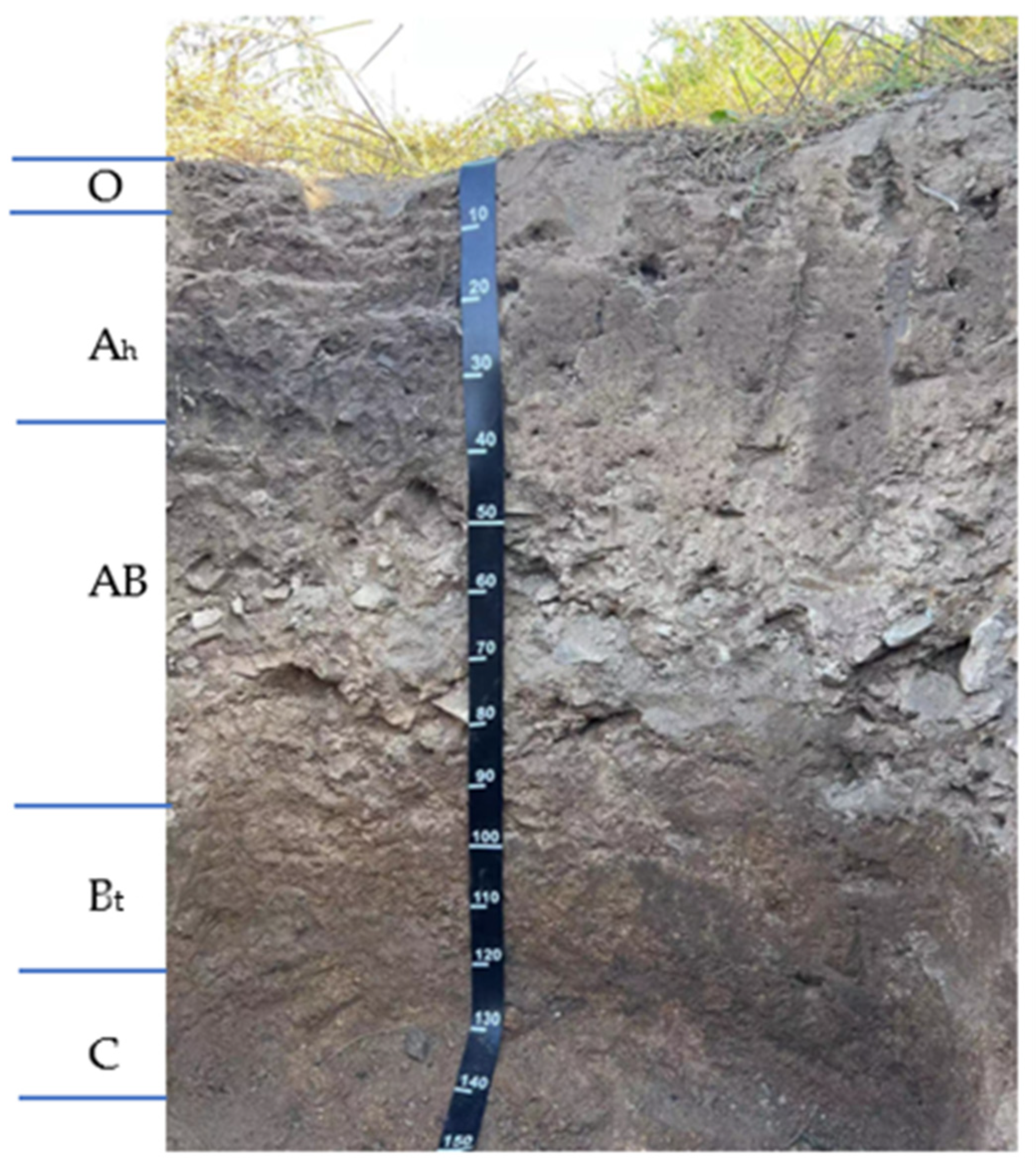

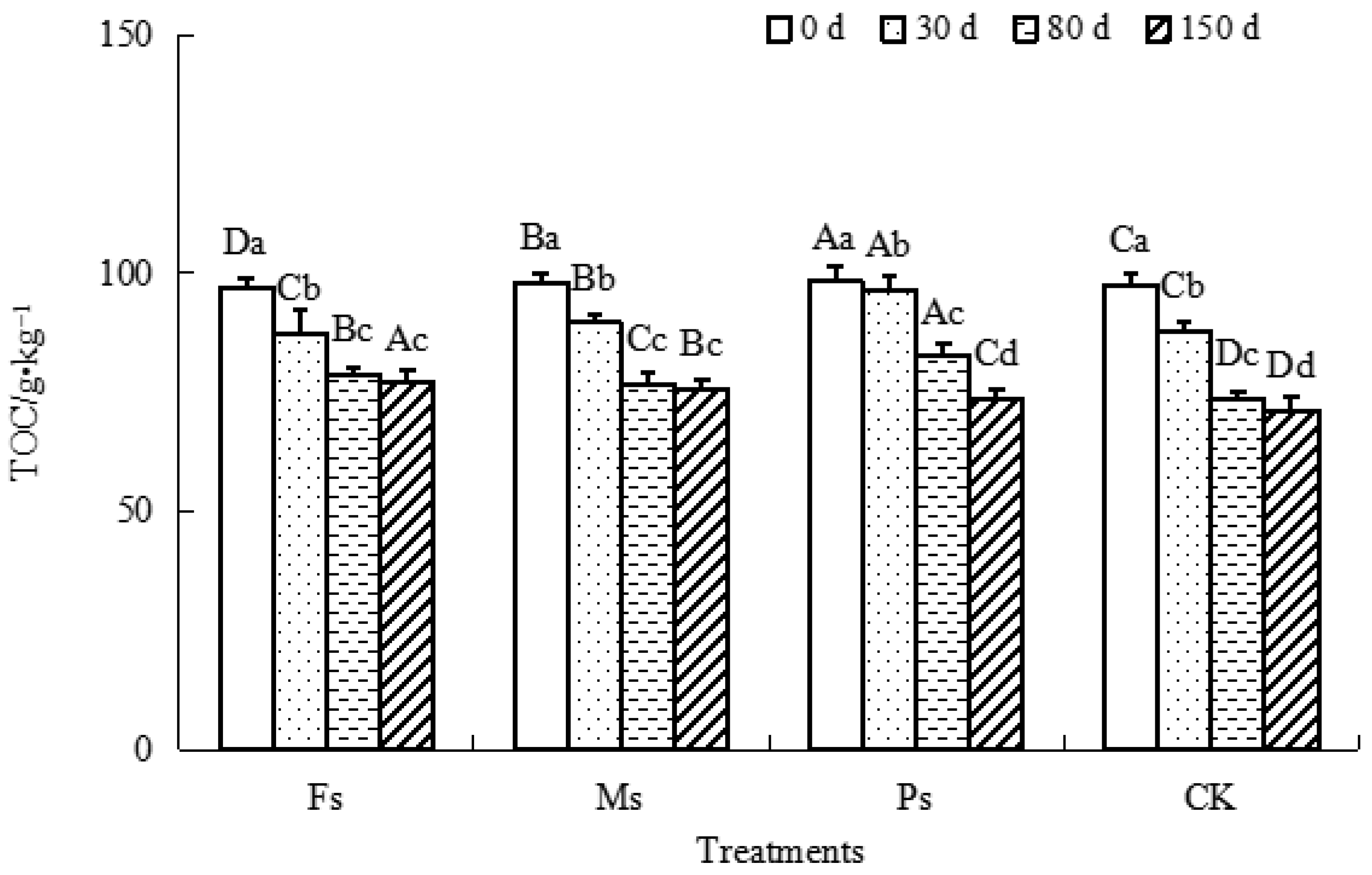

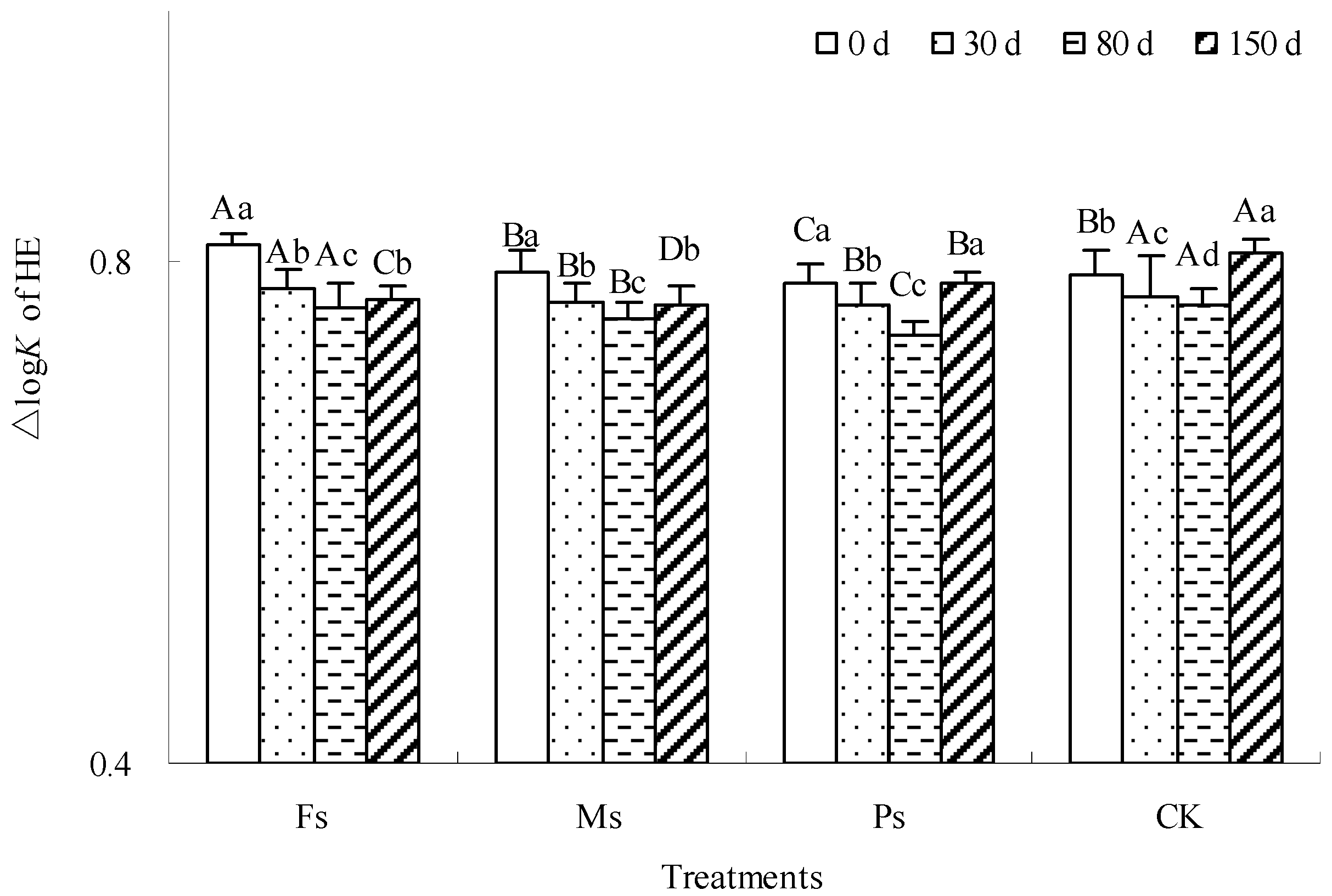

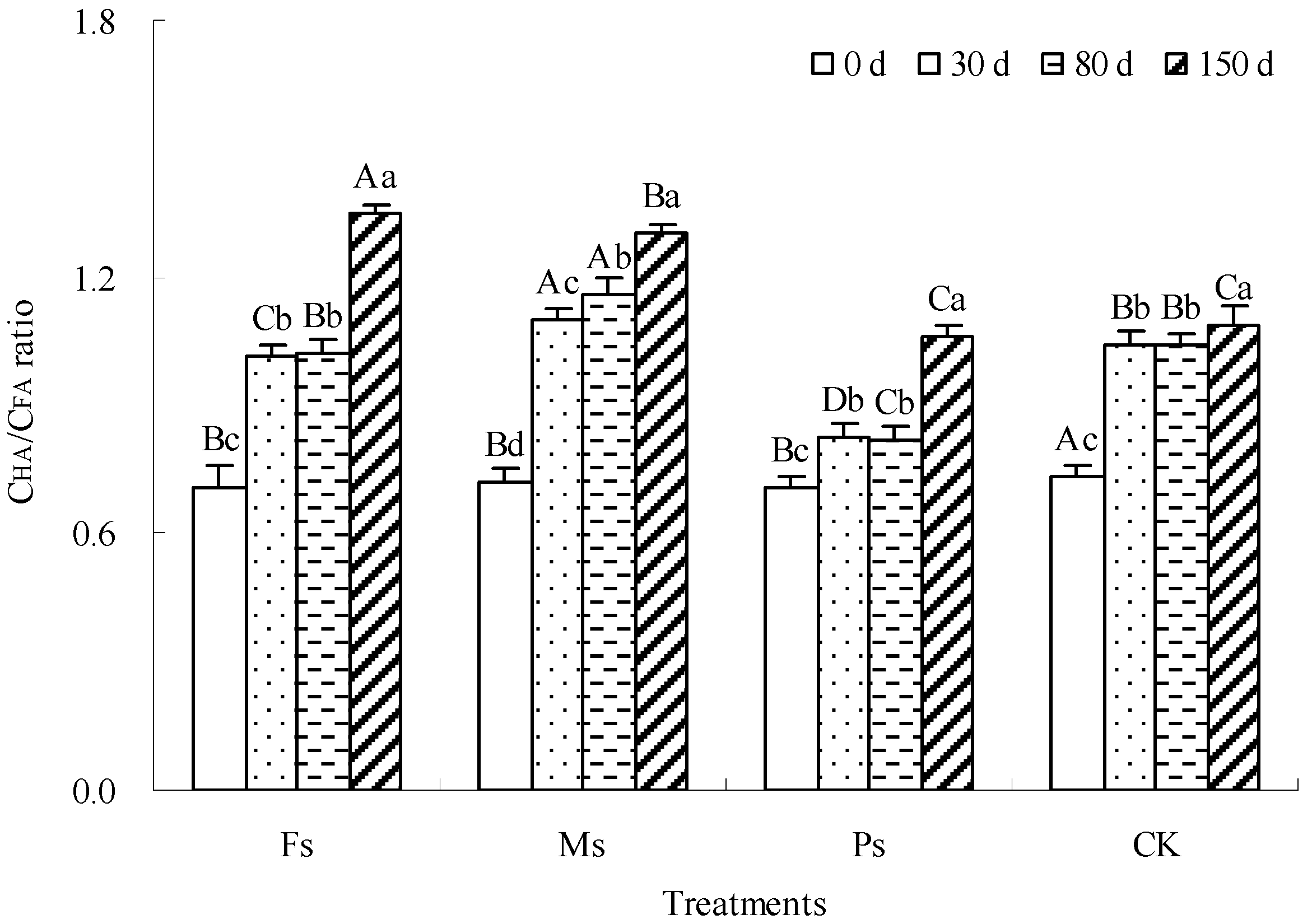
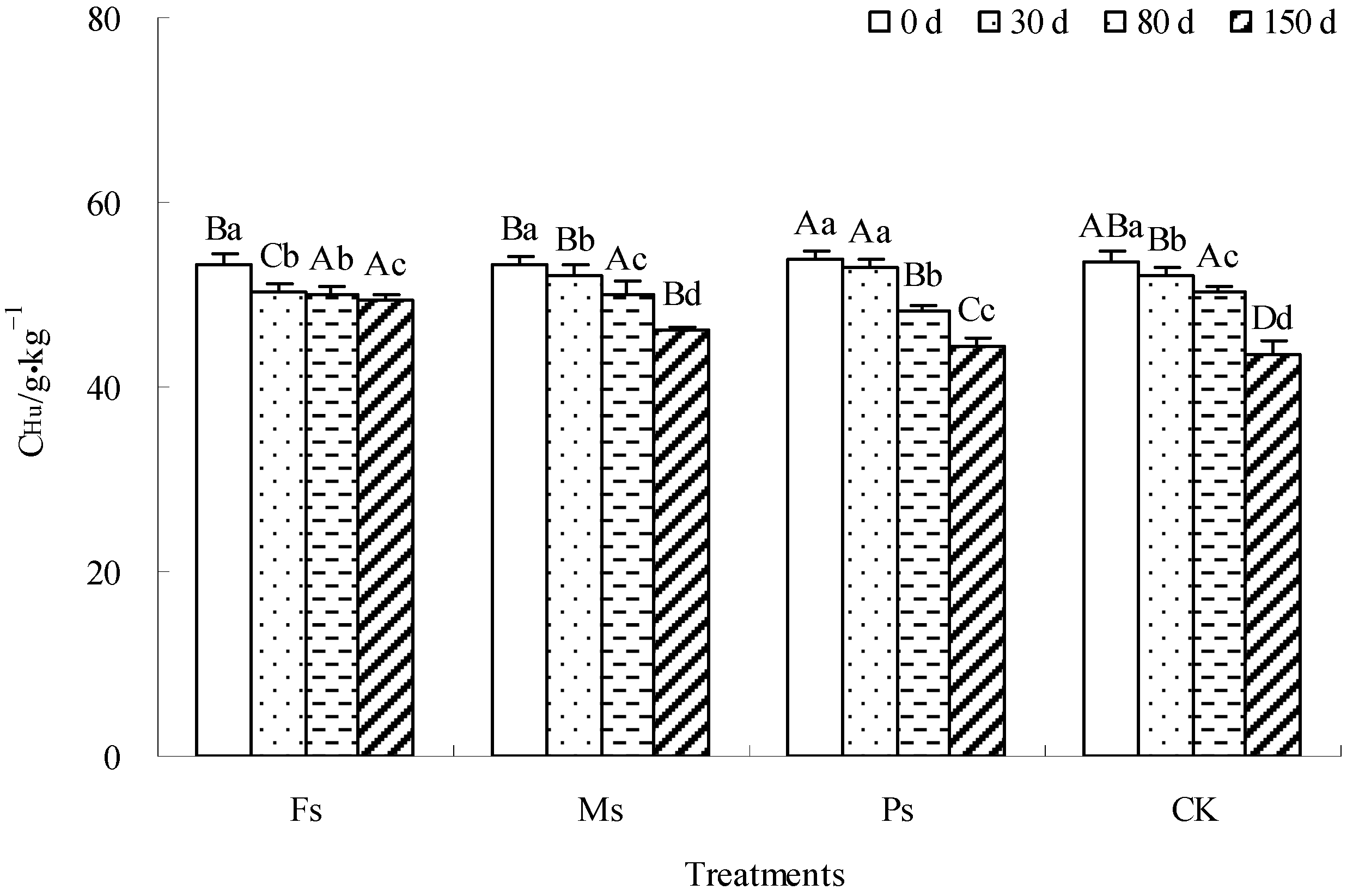
| Treatments | H/C Ratio | C/N Ratio | O/C Ratio |
|---|---|---|---|
| Fs0 | 1.59 ± 0.03 a | 13.3 ± 0.4 a | 0.71 ± 0.01 c |
| Fs80 | 1.52 ± 0.01 b | 12.3 ± 0.3 b | 0.83 ± 0.02 b |
| Fs150 | 1.49 ± 0.02 c | 11.6 ± 0.1 c | 1.02 ± 0.04 a |
| Ms0 | 1.64 ± 0.04 a | 14.9 ± 0.5 a | 0.98 ± 0.02 c |
| Ms80 | 1.60 ± 0.02 b | 12.4 ± 0.1 b | 1.04 ± 0.05 b |
| Ms150 | 1.54 ± 0.03 c | 12.5 ± 0.2 b | 1.16 ± 0.06 a |
| Ps0 | 1.56 ± 0.04 a | 13.3 ± 0.3 a | 0.79 ± 0.02 c |
| Ps80 | 1.53 ± 0.01 b | 12.7 ± 0.2 b | 0.91 ± 0.03 b |
| Ps150 | 1.52 ± 0.02 b | 12.3 ± 0.2 c | 0.93 ± 0.04 a |
| CK0 | 1.53 ± 0.01 b | 13.3 ± 0.1 b | 0.72 ± 0.01 c |
| CK80 | 1.55 ± 0.02 a | 13.2 ± 0.2 b | 0.84 ± 0.04 b |
| CK150 | 1.56 ± 0.02 a | 13.5 ± 0.2 a | 0.86 ± 0.05 a |
| Treatments | 3413–3415 | 2929–2964 a | 1618–1620 c | 1450–1452 b | 1119–1120 | (a + b)/c |
| Fs0 | 72.3 | 1.5 | 15.3 | 5.3 | 2.7 | 13.7 |
| Fs80 | 73.4 | 1.3 | 16.4 | 2.3 | 4.3 | 14.4 |
| Fs150 | 74.1 | 1.2 | 16.5 | 3.2 | 3.2 | 16.4 |
| 3413 | 2927–2966 a | 1618 c | 1452–1454 b | 1119–1120 | (a + b)/c | |
| Ms0 | 65.6 | 1.5 | 11.3 | 14.5 | 3.9 | 17.2 |
| Ms80 | 67.2 | 1.2 | 11.1 | 13.3 | 4.2 | 20.3 |
| Ms150 | 71.6 | 0.9 | 11.8 | 8.1 | 3.6 | 22.1 |
| 3411–3415 | 2927–2931 a | 1618 c | 1389–1394 b | 1038–1039 | (a + b)/c | |
| Ps0 | 62.1 | 1.3 | 25.1 | 6.1 | 4.8 | 24.0 |
| Ps80 | 64.2 | 1.2 | 24.5 | 4.4 | 6.1 | 24.1 |
| Ps150 | 65.3 | 1.1 | 24.4 | 4.0 | 5.3 | 25.8 |
| 3415.34 | 2927–2929 a | 1618 c | 1389–1392 b | 1036–1039 | (a + b)/c | |
| CK0 | 69.1 | 1.5 | 18.1 | 2.9 | 6.1 | 14.0 |
| CK80 | 64.7 | 1.6 | 18.2 | 3.4 | 10.5 | 13.5 |
| CK150 | 62.2 | 1.9 | 20.8 | 5.2 | 7.9 | 13.7 |
Disclaimer/Publisher’s Note: The statements, opinions and data contained in all publications are solely those of the individual author(s) and contributor(s) and not of MDPI and/or the editor(s). MDPI and/or the editor(s) disclaim responsibility for any injury to people or property resulting from any ideas, methods, instructions or products referred to in the content. |
© 2023 by the authors. Licensee MDPI, Basel, Switzerland. This article is an open access article distributed under the terms and conditions of the Creative Commons Attribution (CC BY) license (https://creativecommons.org/licenses/by/4.0/).
Share and Cite
Wang, N.; Liu, Z.; Bai, C.; Li, R.; Li, M.; Wang, Y.; Yu, W.; Liu, P.; Yin, R.; Wang, S. Effect of Metal Cations with Different Valences on the Humus Composition of Dark-Brown Soil Mixed with Tilia Wood Shavings. Agronomy 2023, 13, 2681. https://doi.org/10.3390/agronomy13112681
Wang N, Liu Z, Bai C, Li R, Li M, Wang Y, Yu W, Liu P, Yin R, Wang S. Effect of Metal Cations with Different Valences on the Humus Composition of Dark-Brown Soil Mixed with Tilia Wood Shavings. Agronomy. 2023; 13(11):2681. https://doi.org/10.3390/agronomy13112681
Chicago/Turabian StyleWang, Nan, Zhijiang Liu, Chengxin Bai, Ren Li, Min Li, Ying Wang, Wenting Yu, Pingxin Liu, Ruisi Yin, and Shuai Wang. 2023. "Effect of Metal Cations with Different Valences on the Humus Composition of Dark-Brown Soil Mixed with Tilia Wood Shavings" Agronomy 13, no. 11: 2681. https://doi.org/10.3390/agronomy13112681
APA StyleWang, N., Liu, Z., Bai, C., Li, R., Li, M., Wang, Y., Yu, W., Liu, P., Yin, R., & Wang, S. (2023). Effect of Metal Cations with Different Valences on the Humus Composition of Dark-Brown Soil Mixed with Tilia Wood Shavings. Agronomy, 13(11), 2681. https://doi.org/10.3390/agronomy13112681






